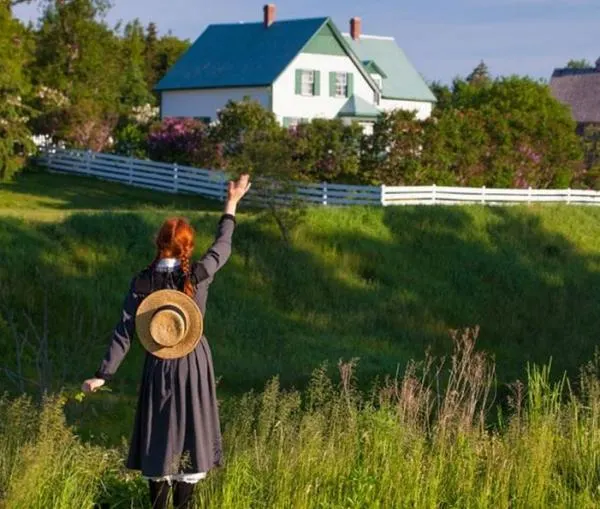Chapter IV: Morning at Green Gables
By Lucy Maud Montgomery
Annotations by Mary Miller

CHAPTER IV: Morning at Green Gables
IT was broad daylight when Anne awoke and sat up in bed, staring confusedly at the window through which a flood of cheery sunshine was pouring and outside of which something white and feathery waved across glimpses of blue sky. For a moment she could not remember where she was. First came a delightful thrill, as something very pleasant; then a horrible remembrance. This was Green Gables and they didn’t want her because she wasn’t a boy! But it was morning and, yes, it was a cherry-tree in full bloom outside of her window. With a bound she was out of bed and across the floor. She pushed up the sash–it went up stiffly and creakily, as if it hadn’t been opened for a long time, which was the case; and it stuck so tight that nothing was needed to hold it up. Anne dropped on her knees and gazed out into the June morning, her eyes glistening with delight. Oh, wasn’t it beautiful? Wasn’t it a lovely place? Suppose she wasn’t really going to stay here! She would imagine she was. There was scope for imagination [1] here. A huge cherry-tree grew outside, so close that its boughs tapped against the house, and it was so thick-set with blossoms that hardly a leaf was to be seen. On both sides of the house was a big orchard, one of apple-trees and one of cherry-trees, also showered over with blossoms; and their grass was all sprinkled with dandelions. In the garden below were lilac-trees purple with flowers, and their dizzily sweet fragrance drifted up to the window on the morning wind. Below the garden a green field lush with clover sloped down to the hollow where the brook ran and where scores of white birches grew, upspringing airily out of an undergrowth suggestive of delightful possibilities in ferns and mosses and woodsy things generally. Beyond it was a hill, green and feathery with spruce and fir; [2] there was a gap in it where the gray gable end of the little house she had seen from the other side of the Lake of Shining Waters [3] was visible. Off to the left were the big barns and beyond them, away down over green, low-sloping fields, was a sparkling blue glimpse of sea. Anne’s beauty-loving eyes lingered on it all, taking everything greedily in. She had looked on so many unlovely places in her life, poor child; but this was as lovely as anything she had ever dreamed. She knelt there, lost to everything but the loveliness around her, until she was startled by a hand on her shoulder. Marilla had come in unheard by the small dreamer.
Montgomery, L. M. Anne of Green Gables. Boston: L. C. Page & Co., 1908.
[1] “Scope for imagination” is a phrase Anne uses frequently when she is inspired by nature, people, or events.
[2] Montgomery describes the trees surrounding Green Gables through Anne’s eyes. There are blooming cherry and apples trees as well as purple-blossomed lilac trees. The lilacs are especially romantic because of their sweet fragrance which perfumes the air in early spring.
[3] Lake of the Shining Water was the name Anne gave to a small pond on the farm. She had an extraordinary imagination and often gave names to things that inspired her spirit.
Contexts
Lucy Maud Montgomery’s novel Anne of Green Gables was published in 1908. The setting is a small community on Prince Edward Island in Canada. This was a time when women’s rights were greatly restricted, in Canada and throughout the world. The book tells the story of an orphan girl who is desperate for a loving family. She is sent to help two older people, a brother and sister, who live in a house called Green Gables. Matthew and Marilla Cuthbert have never been married and have no experience raising children. They have requested to adopt a boy who could help with farm chores. Instead, Anne arrives. Marilla is ready to send her back to the orphanage, but Matthew is quickly charmed by Anne’s happy and inquisitive personality and her love of the beautiful countryside in Avonlea, the town where she finds her new home. The story touches on the plight of women in the late eighteenth and early twentieth centuries as Anne struggles to live out her dreams. Montgomery’s ability to paint pictures with language is demonstrated magnificently in the book through Anne’s words. This early chapter is a lovely introduction to the beginning of Anne’s life in Avonlea with the Cuthberts.
.
Resources for Further Study
- You can easily find the book by searching for” Anne of Green Gables” online or on Amazon.
- Watch the series “Anne with an E” on Netflix and try not to cry at least once.
- Learn more about Lucy Maud Montgomery by reading Mary Henley Rubio’s biography “Lucy Maud Montgomery: The Gift of Wings” published in 2010 by Anchor Canada.
- Visit the Canadian historical site, Green Gables Heritage Place if you plan to visit Prince Edward Island in Canada.
Definitions from Oxford English Dictionary:
gable: the upper part of the end wall of a building, between the two sloping sides of the roof, that is shaped like a triangle.
sash: either of a pair of windows, one above the other, that are opened and closed by sliding them up and down inside the frame.
Contemporary Connections
Lucy Maud Montgomery struggled to overcome sexism as a female writer at a time when it was not considered an appropriate aspiration for women. She fought a courageous battle to become one of Canada’s most beloved novelists, and supported her family almost entirely with her publishing income. Historica Canada created a Heritage Minute video on Montgomery for International Women’s Day in 2018.